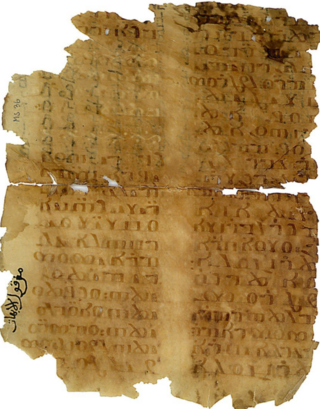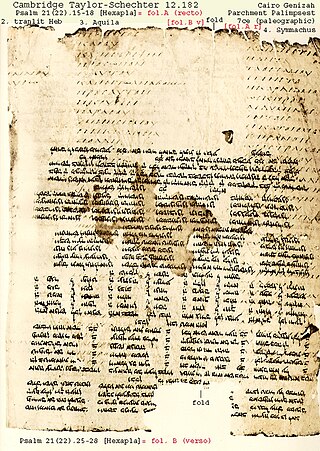
Solomon Schechter was a Moldavian-born British-American rabbi, academic scholar and educator, most famous for his roles as founder and President of the United Synagogue of America, President of the Jewish Theological Seminary of America, and architect of American Conservative Judaism.

A genizah is a storage area in a Jewish synagogue or cemetery designated for the temporary storage of worn-out Hebrew-language books and papers on religious topics prior to proper cemetery burial.

The Cairo Geniza, alternatively spelled the Cairo Genizah, is a collection of some 400,000 Jewish manuscript fragments and Fatimid administrative documents that were kept in the genizah or storeroom of the Ben Ezra Synagogue in Fustat or Old Cairo, Egypt. These manuscripts span the entire period of Middle-Eastern, North African, and Andalusian Jewish history between the 6th and 19th centuries CE, and comprise the largest and most diverse collection of medieval manuscripts in the world.

Hexapla, also called Origenis Hexaplorum, is a critical edition of the Hebrew Bible in six versions, four of them translated into Greek, preserved only in fragments. It was an immense and complex word-for-word comparison of the original Hebrew Scriptures with the Greek Septuagint translation and with other Greek translations. The term especially and generally applies to the edition of the Old Testament compiled by the theologian and scholar Origen sometime before 240.
Aquilaof Sinope was a translator of the Hebrew Bible into Greek, a proselyte, and disciple of Rabbi Akiva.
Samuel ben Hofni was the gaon of Sura Academy in Mesopotamia ("Babylonia") from 998 to 1012.

The Curetonian Gospels, designated by the siglum syrcur, are contained in a manuscript of the four gospels of the New Testament in Old Syriac. Together with the Sinaiticus Palimpsest the Curetonian Gospels form the Old Syriac Version, and are known as the Evangelion Dampharshe in the Syriac Orthodox Church.

Charles Taylor (1840–1908) was an English Christian Hebraist.

The Tetragrammaton is the four-letter Hebrew theonym יהוה, the name of God in the Hebrew Bible. The four letters, written and read from right to left, are yodh, he, waw, and he. The name may be derived from a verb that means "to be", "to exist", "to cause to become", or "to come to pass". While there is no consensus about the structure and etymology of the name, the form Yahweh is now accepted almost universally among Biblical and Semitic linguistics scholars, though the vocalization Jehovah continues to have wide usage.

Christian Palestinian Aramaic was a Western Aramaic dialect used by the Melkite Christian community, probably of Jewish descent, in Palestine, Transjordan and Sinai between the fifth and thirteenth centuries. It is preserved in inscriptions, manuscripts and amulets. All the medieval Western Aramaic dialects are defined by religious community. CPA is closely related to its counterparts, Jewish Palestinian Aramaic (JPA) and Samaritan Aramaic (SA). CPA shows a specific vocabulary that is often not paralleled in the adjacent Western Aramaic dialects.

Agnes Smith Lewis (1843–1926) and Margaret Dunlop Gibson (1843–1920), nées Smith, were English Semitic scholars and travellers. As the twin daughters of John Smith of Irvine, Ayrshire, Scotland, they learned more than 12 languages between them, specialising in Arabic, Christian Palestinian Aramaic, and Syriac, and became acclaimed scholars in their academic fields, and benefactors to the Presbyterian Church of England, especially to Westminster College, Cambridge.
Uncial 093, is a Greek uncial manuscript of the New Testament, dated palaeographically to the 6th century. Formerly it was designated by siglum ל.

Psalm 97 is the 97th psalm of the Book of Psalms, beginning in the English of the King James Version: "The Lord reigneth; let the earth rejoice", also as "The Lord is King". The Book of Psalms is part of the third section of the Hebrew Bible, and a book of the Christian Old Testament. In Latin, it is known as "Dominus regnavit exultet terra". The psalm is a hymn psalm; the Jerusalem Bible calls it an "eschatological hymn".

Psalm 102 is the 102nd psalm of the Book of Psalms, beginning in English in the King James Version: "Hear my prayer, O LORD, and let my cry come unto thee." In Latin, it is known as "Domine exaudi orationem meam".
The Papyrus Vindobonensis Graecus 39777 signed as SymP.Vindob.G.39777 – is a fragment of a Greek manuscript of the Psalms of the translation of Symmachus. It was written in papyrus in a scroll form. The papyrus contains fragments of Psalm 69 and Psalm 81. The P.Vindob.G.39777 is dated to late third century or beginning fourth century AD.

Papyrus Oxyrhynchus 5101, designated by 2227, or P.Oxy.77 (LXXVII) 5101, is a manuscript of the Greek Septuagint Psalms, written on papyrus in roll form. It has survived in a very fragmentary condition. Using the study of comparative writings styles (palaeography), it has been dated to the middle of the first - middle of the second century CE.

The AqBurkitt are fragments of a palimpsest containing a portion of the Books of Kings from Aquila's translation of the Hebrew bible from the 6th century, overwritten by some liturgical poems of Yanai dating from the 9–11th century. This Aquila translation was performed approximately in the early or mid-second century C.E. The manuscript is variously dated to the 6th-century CE, or 5th-6th century CE.

The siglum Taylor-Schechter 12.182 designates a manuscript written on parchment in codex form. This is a palimpsest of a copy of Origen's work called the Hexapla. The manuscript is dated to 7th-century AD, and is the oldest of the hexapla manuscripts. The hexapla was completed before 240 AD.
Taylor-Schechter 16.320 is a Greek biblical manuscript written on parchment in codex form. This is a palimpsest that contains the Palestinian Talmud and the Septuagint Psalms. The manuscript is dated 550 – 649 CE.

1 Kings 20 is the 20th chapter of the Books of Kings in the Hebrew Bible or the First Book of Kings in the Old Testament of the Christian Bible. The book is a compilation of various annals recording the acts of the kings of Israel and Judah by a Deuteronomic compiler in the seventh century BCE, with a supplement added in the sixth century BCE. This chapter belongs to the section comprising 1 Kings 16:15 to 2 Kings 8:29 which documents the period of the Omrides. The focus of this chapter is the reign of king Ahab in the northern kingdom.















